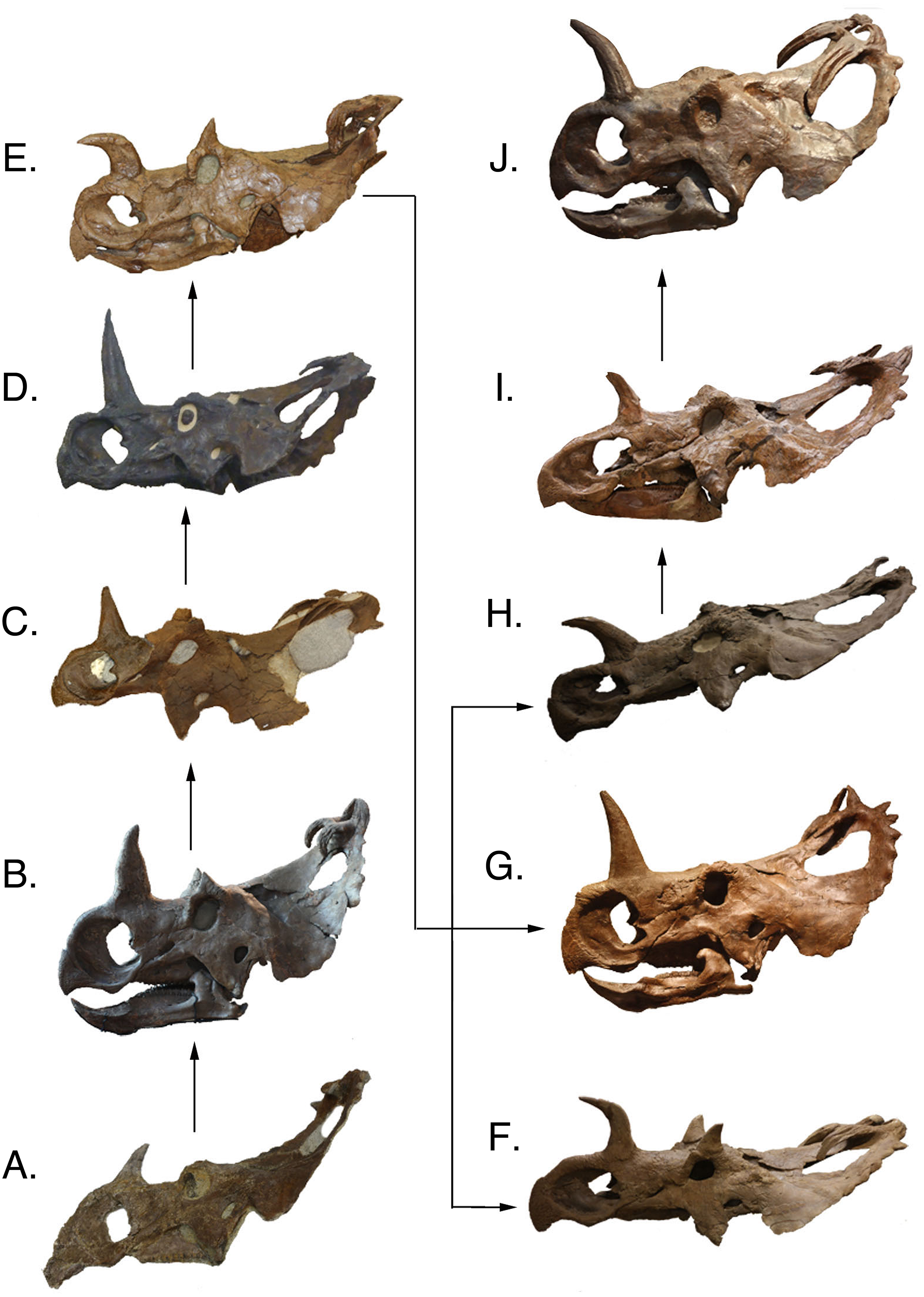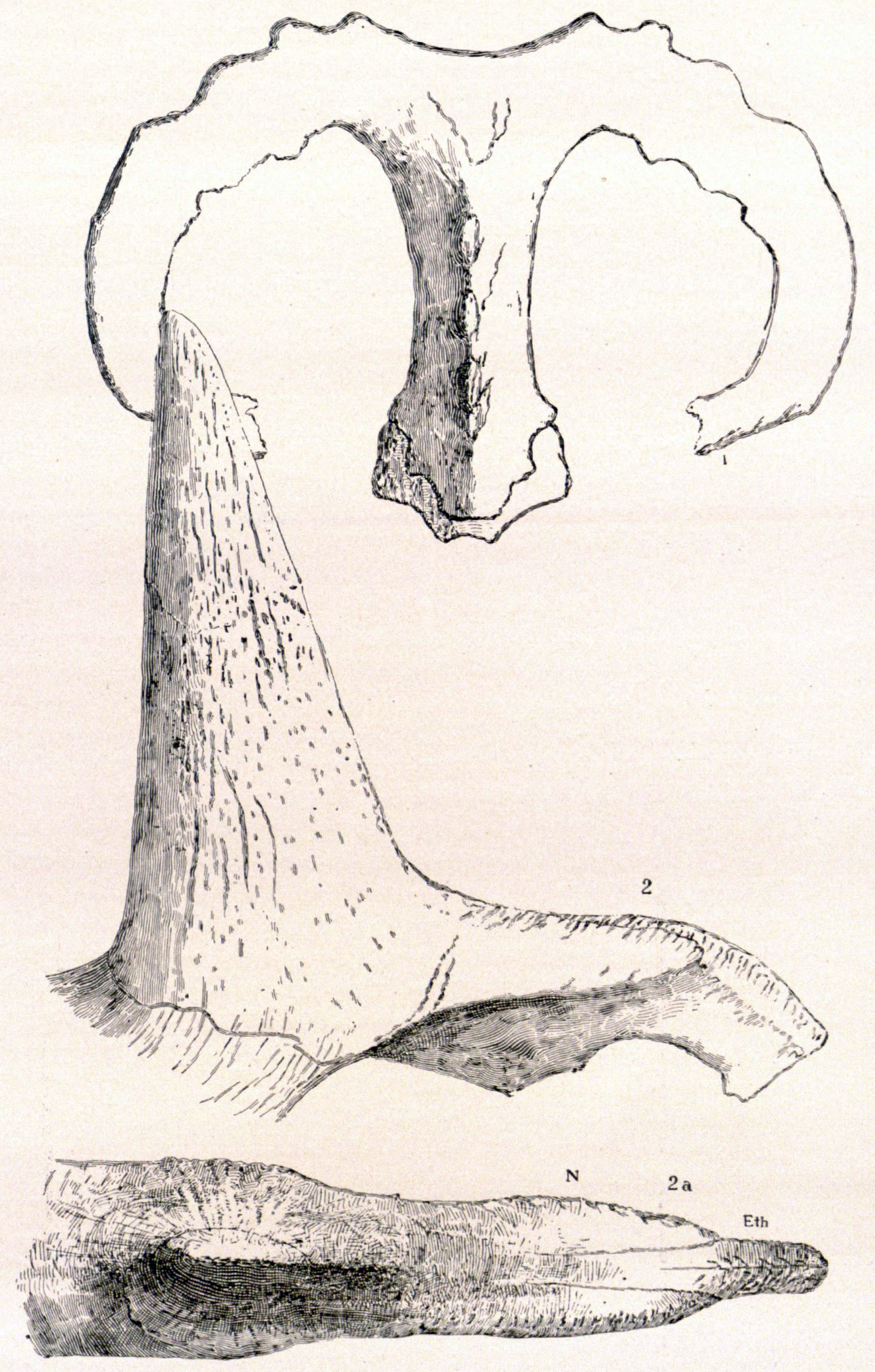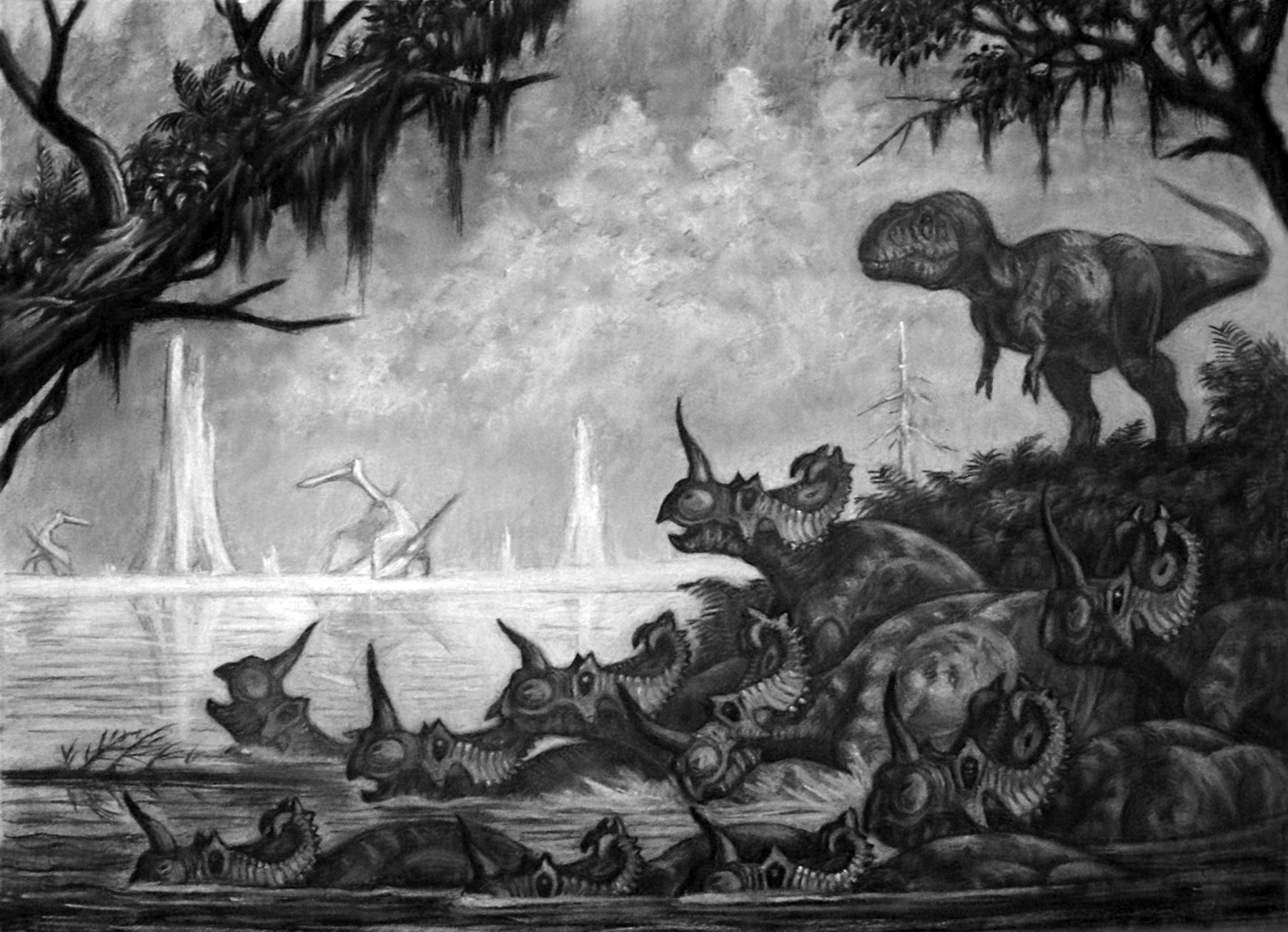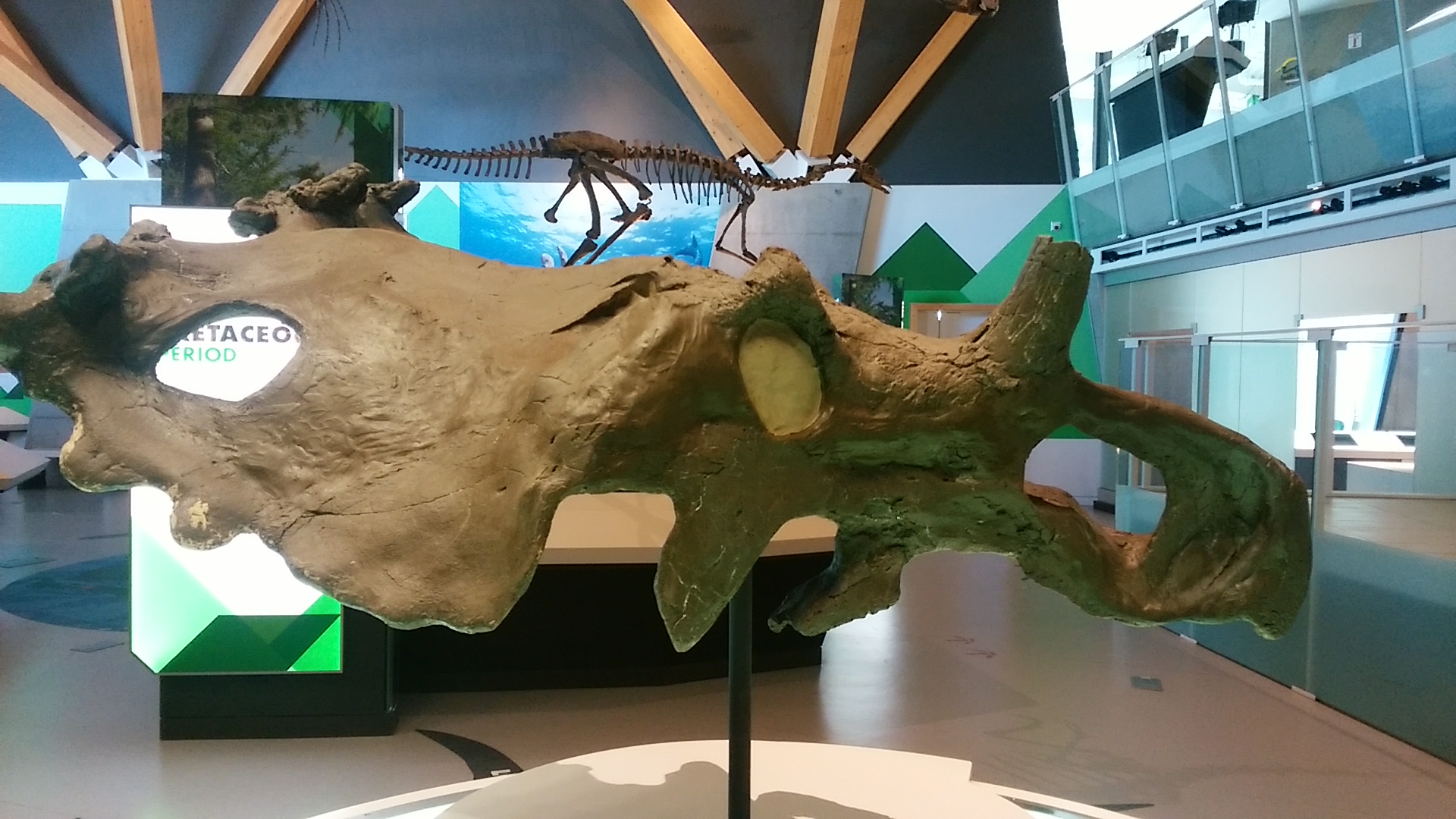|
Centrosaurus
''Centrosaurus'' ( ; ) is a genus of herbivorous ceratopsian dinosaur from the Late Cretaceous of Canada. Their remains have been found in the Dinosaur Park Formation, dating from 76.5 to 75.5 million years ago. Discovery and naming The first ''Centrosaurus'' remains were discovered and named by paleontologist Lawrence Lambe in strata along the Red Deer River in Alberta, Canada. The name ''Centrosaurus'' means "pointed lizard" (from Greek ', , "point or prickle" and ', , "lizard"), and refers to the series of small hornlets placed along the margin of their frills, not to the nasal horns (which were unknown when the dinosaur was named). The genus is not to be confused with the stegosaur '' Kentrosaurus'', the name of which is derived from the same Greek word. Later, vast bonebeds of ''Centrosaurus'' were found in Dinosaur Provincial Park, also in Alberta. Some of these beds extend for hundreds of meters and contain thousands of individuals of all ages and all levels of comple ... [...More Info...] [...Related Items...] OR: [Wikipedia] [Google] [Baidu] |
Centrosaurus
''Centrosaurus'' ( ; ) is a genus of herbivorous ceratopsian dinosaur from the Late Cretaceous of Canada. Their remains have been found in the Dinosaur Park Formation, dating from 76.5 to 75.5 million years ago. Discovery and naming The first ''Centrosaurus'' remains were discovered and named by paleontologist Lawrence Lambe in strata along the Red Deer River in Alberta, Canada. The name ''Centrosaurus'' means "pointed lizard" (from Greek ', , "point or prickle" and ', , "lizard"), and refers to the series of small hornlets placed along the margin of their frills, not to the nasal horns (which were unknown when the dinosaur was named). The genus is not to be confused with the stegosaur '' Kentrosaurus'', the name of which is derived from the same Greek word. Later, vast bonebeds of ''Centrosaurus'' were found in Dinosaur Provincial Park, also in Alberta. Some of these beds extend for hundreds of meters and contain thousands of individuals of all ages and all levels of comple ... [...More Info...] [...Related Items...] OR: [Wikipedia] [Google] [Baidu] |
Centrosaurus Scale
''Centrosaurus'' ( ; ) is a genus of herbivorous ceratopsian dinosaur from the Late Cretaceous of Canada. Their remains have been found in the Dinosaur Park Formation, dating from 76.5 to 75.5 million years ago. Discovery and naming The first ''Centrosaurus'' remains were discovered and named by paleontologist Lawrence Lambe in strata along the Red Deer River in Alberta, Canada. The name ''Centrosaurus'' means "pointed lizard" (from Greek ', , "point or prickle" and ', , "lizard"), and refers to the series of small hornlets placed along the margin of their frills, not to the nasal horns (which were unknown when the dinosaur was named). The genus is not to be confused with the stegosaur '' Kentrosaurus'', the name of which is derived from the same Greek word. Later, vast bonebeds of ''Centrosaurus'' were found in Dinosaur Provincial Park, also in Alberta. Some of these beds extend for hundreds of meters and contain thousands of individuals of all ages and all levels of complet ... [...More Info...] [...Related Items...] OR: [Wikipedia] [Google] [Baidu] |
Centrosaurus Parietal Hook By Nick Longrich
''Centrosaurus'' ( ; ) is a genus of herbivorous ceratopsian dinosaur from the Late Cretaceous of Canada. Their remains have been found in the Dinosaur Park Formation, dating from 76.5 to 75.5 million years ago. Discovery and naming The first ''Centrosaurus'' remains were discovered and named by paleontologist Lawrence Lambe in strata along the Red Deer River in Alberta, Canada. The name ''Centrosaurus'' means "pointed lizard" (from Greek ', , "point or prickle" and ', , "lizard"), and refers to the series of small hornlets placed along the margin of their frills, not to the nasal horns (which were unknown when the dinosaur was named). The genus is not to be confused with the stegosaur '' Kentrosaurus'', the name of which is derived from the same Greek word. Later, vast bonebeds of ''Centrosaurus'' were found in Dinosaur Provincial Park, also in Alberta. Some of these beds extend for hundreds of meters and contain thousands of individuals of all ages and all levels of complet ... [...More Info...] [...Related Items...] OR: [Wikipedia] [Google] [Baidu] |
Centrosaurus Skulls
''Centrosaurus'' ( ; ) is a genus of herbivorous ceratopsian dinosaur from the Late Cretaceous of Canada. Their remains have been found in the Dinosaur Park Formation, dating from 76.5 to 75.5 million years ago. Discovery and naming The first ''Centrosaurus'' remains were discovered and named by paleontologist Lawrence Lambe in strata along the Red Deer River in Alberta, Canada. The name ''Centrosaurus'' means "pointed lizard" (from Greek ', , "point or prickle" and ', , "lizard"), and refers to the series of small hornlets placed along the margin of their frills, not to the nasal horns (which were unknown when the dinosaur was named). The genus is not to be confused with the stegosaur '' Kentrosaurus'', the name of which is derived from the same Greek word. Later, vast bonebeds of ''Centrosaurus'' were found in Dinosaur Provincial Park, also in Alberta. Some of these beds extend for hundreds of meters and contain thousands of individuals of all ages and all levels of complet ... [...More Info...] [...Related Items...] OR: [Wikipedia] [Google] [Baidu] |
Monoclonius
''Monoclonius'' (meaning "single sprout") is a dubious genus of herbivorous ceratopsian dinosaur found in the Late Cretaceous layers of the Judith River Formation in Montana, United States, and the uppermost rock layers of the Dinosaur Park Formation in Alberta, Canada dated to between 75 and 74.6 million years ago. ''Monoclonius'' was named by Edward Drinker Cope in 1876. Later, much taxonomic confusion was caused by the discovery of ''Centrosaurus'', a very similar genus of ceratopsian that is known from much better remains. Today, typical ''Monoclonius'' specimens are usually believed to be juveniles or subadults, in many cases of other genera such as ''Centrosaurus''. Those specimens that remain under the name ''Monoclonius'' are mostly too incomplete or immature to be confidently matched with adult specimens from the same time and place. This is especially true of the type species, ''Monoclonius crassus''. Therefore, ''Monoclonius'' is now usually considered a ''nomen dubiu ... [...More Info...] [...Related Items...] OR: [Wikipedia] [Google] [Baidu] |
Hilda Mega-bonebed
The Hilda mega-bonebed is a complex of fourteen probable ''Centrosaurus apertus'' bonebeds discovered near the town of Hilda in Alberta, Canada. It was first described in the scientific literature by David Eberth, Donald Brinkman, and Vaia Barkas in 2010 after more than ten years of research. The Hilda mega-bonebed is significant because the behavior of the preserved dinosaurs themselves was the dominant cause of its existence, rather than the stratum's geological history like most bonebeds. It is also Canada's largest bonebed. History of research In 1959, Wann Langston, Jr. recorded evidence of a ''Centrosaurus'' bonebed near Hilda, Alberta. Later, between 1964 and 1966 Don Taylor of the Provincial Museum of Alberta (now called the Royal Alberta Museum) oversaw the collection of fossils from yet another bonebed in the same region. These prospective bonebeds attracted the attention of scientists working for the Royal Tyrell Museum in the 1990s because Hilda was an ideal locat ... [...More Info...] [...Related Items...] OR: [Wikipedia] [Google] [Baidu] |
Styracosaurus
''Styracosaurus'' ( ; meaning "spiked lizard" from the Ancient Greek / "spike at the butt-end of a spear-shaft" and / "lizard") is a genus of herbivorous ceratopsian dinosaur from the Cretaceous Period (Campanian stage), about 75.5 to 74.5 million years ago. It had four to six long parietal spikes extending from its neck frill, a smaller jugal horn on each of its cheeks, and a single horn protruding from its nose, which may have been up to long and wide. The function or functions of the horns and frills have been debated for many years. ''Styracosaurus'' was a relatively large dinosaur, reaching lengths of and weighing about . It stood about tall. ''Styracosaurus'' possessed four short legs and a bulky body. Its tail was rather short. The skull had a beak and shearing cheek teeth arranged in continuous dental batteries, suggesting that the animal sliced up plants. Like other ceratopsians, this dinosaur may have been a herd animal, travelling in large groups, as s ... [...More Info...] [...Related Items...] OR: [Wikipedia] [Google] [Baidu] |
Coronosaurus
''Coronosaurus'' is a genus of centrosaurine ceratopsian dinosaurs which lived in the Late Cretaceous, in the middle Campanian stage. Its remains, two bone beds, were discovered by Phillip J. Currie in the Oldman Formation of Alberta, Canada, and its type and only species, ''Coronosaurus brinkmani'', was first described in 2005, as a new species within the genus '' Centrosaurus''. Later studies questioned the presence of a direct relationship, and in 2012 it was named as a separate genus. ''Coronosaurus'' means "crowned lizard", coming from "''corona''", Latin for crown, and "''sauros''", Greek for lizard; this name refers to the unique, crown-like shape of the horns on the top of its frill. Like other ceratopsids, ''Coronosaurus'' had a large frill and horns on its head. These include a small pair of brow horns over its eyes, a large nasal horn on its snout, and, unique among ceratopsians, irregular, spiky bone masses on its frill. Growing up to around long and in weight, i ... [...More Info...] [...Related Items...] OR: [Wikipedia] [Google] [Baidu] |
Einiosaurus
''Einiosaurus'' is a genus of herbivorous centrosaurine ceratopsian dinosaur from the Upper Cretaceous (Campanian stage) of northwestern Montana. The name means 'buffalo lizard', in a combination of Blackfeet Indian ''eini'' and Latinized Ancient Greek ''sauros''; the specific name (''procurvicornis'') means 'with a forward-curving horn' in Latin. ''Einiosaurus'' is medium-sized with an estimated body length at . History of discovery The Landslide Butte expeditions ''Einiosaurus'' is an exclusively Montanan dinosaur, and all of its known remains are currently held at the Museum of the Rockies in Bozeman, Montana. At least fifteen individuals of varying ages are represented by three adult skulls and hundreds of other bones from two low-diversity, monospecific (one species) bonebeds, which were discovered by Jack Horner in 1985 and excavated from 1985 to 1989 by Museum of the Rockies field crews. Horner had not been searching for horned dinosaurs. In the spring of 1985 he ha ... [...More Info...] [...Related Items...] OR: [Wikipedia] [Google] [Baidu] |
Dinosaur Park Formation
The Dinosaur Park Formation is the uppermost member of the Belly River Group (also known as the Judith River Group), a major geologic unit in southern Alberta. It was deposited during the Campanian stage of the Late Cretaceous, between about 76.5 and 74.4 million years ago. It was deposited in alluvial plain, alluvial and coastal plain environments, and it is bounded by the nonmarine Oldman Formation below it and the marine (ocean), marine Bearpaw Formation above it.Eberth, D.A. 2005. The geology. In: Currie, P.J., and Koppelhus, E.B. (eds), Dinosaur Provincial Park: A Spectacular Ancient Ecosystem Revealed. Indiana University Press: Bloomington and Indianapolis, p.54-82. . The Dinosaur Park Formation contains dense concentrations of dinosaur skeletons, both articulated and disarticulated, which are often found with preserved remains of soft tissues. Remains of other animals such as fish, turtles, and crocodilians, as well as plant remains, are also abundant. The formation h ... [...More Info...] [...Related Items...] OR: [Wikipedia] [Google] [Baidu] |
Dinosaurs
Dinosaurs are a diverse group of reptiles of the clade Dinosauria. They first appeared during the Triassic period, between 243 and 233.23 million years ago (mya), although the exact origin and timing of the evolution of dinosaurs is the subject of active research. They became the dominant terrestrial vertebrates after the Triassic–Jurassic extinction event 201.3 mya; their dominance continued throughout the Jurassic and Cretaceous periods. The fossil record shows that birds are feathered dinosaurs, having evolved from earlier theropods during the Late Jurassic epoch, and are the only dinosaur lineage known to have survived the Cretaceous–Paleogene extinction event approximately 66 mya. Dinosaurs can therefore be divided into avian dinosaurs—birds—and the extinct non-avian dinosaurs, which are all dinosaurs other than birds. Dinosaurs are varied from taxonomic, morphological and ecological standpoints. Birds, at over 10,700 living species, are am ... [...More Info...] [...Related Items...] OR: [Wikipedia] [Google] [Baidu] |
Ceratopsidae
Ceratopsidae (sometimes spelled Ceratopidae) is a family of ceratopsian dinosaurs including ''Triceratops'', '' Centrosaurus'', and ''Styracosaurus''. All known species were quadrupedal herbivores from the Upper Cretaceous. All but one species are known from western North America, which formed the island continent of Laramidia during most of the Late Cretaceous. Ceratopsids are characterized by beaks, rows of shearing teeth in the back of the jaw, elaborate nasal horns, and a thin parietal-squamosal shelf that extends back and up into a frill. The group is divided into two subfamilies—Chasmosaurinae and Centrosaurinae. The chasmosaurines are generally characterized by long, triangular frills and well-developed brow horns. The centrosaurines had well-developed nasal horns or nasal bosses, shorter and more rectangular frills, and elaborate spines on the back of the frill. These horns and frills show remarkable variation and are the principal means by which the various species hav ... [...More Info...] [...Related Items...] OR: [Wikipedia] [Google] [Baidu] |










